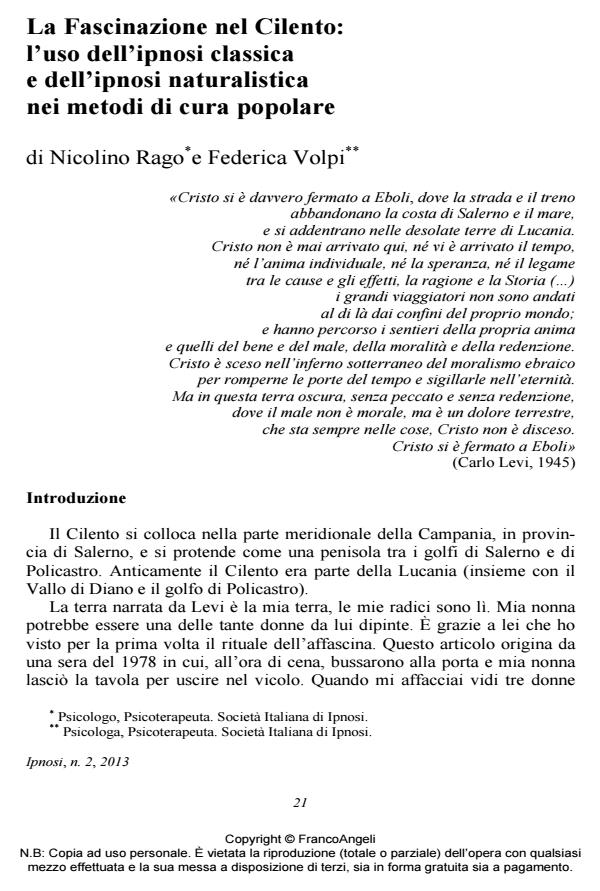La Fascinazione nel Cilento: l’uso dell’ipnosi classica e dell’ipnosi naturalistica nei metodi di cura popolare
Journal title IPNOSI
Author/s Nicolino Rago, Federica Volpi
Publishing Year 2013 Issue 2013/2
Language Italian Pages 15 P. 21-35 File size 376 KB
DOI 10.3280/IPN2013-008002
DOI is like a bar code for intellectual property: to have more infomation
click here
Below, you can see the article first page
If you want to buy this article in PDF format, you can do it, following the instructions to buy download credits

FrancoAngeli is member of Publishers International Linking Association, Inc (PILA), a not-for-profit association which run the CrossRef service enabling links to and from online scholarly content.
The Fascination: use of classical hypnosis and naturalistic hypnosis in the popular treatment. The term "fascination" refers to a mental condition of impediment and inhibition, and at the same time to a sense of domination, to a sense of being possessed by an occult and powerful force, which leaves no margin of autonomy to the person and his decision-making capacity. "Fascination" is often accompanied by headache, drowsiness, and fatigue, but the experience of an indomitable and deadly force, along with the desire to be freed from this domination, remains the hallmark of the underlying condition. In this work, the authors propose a comparison between the popular treatment of "fascination" and hypnotherapy. In particular, they want to explore three areas: 1) the related state of trance (both of the "rimediante", i.e., the person who exercises the procedure, and of the "fascinated" subject); 2) the associated metaphorical language (the metaphorical element is central to the rite of "fascination" and to all formulae used by the "rimedianti", since it allows the introduction of the dimension of the "as if" and to operate for a positive change); 3) the rapport.
Con il termine "fascinazione" si indica una condizione psichica di impedimento e di inibizione, e al tempo stesso un senso di dominazione, un essere agito da una forza occulta e potente, che lascia senza margine l’autonomia della persona e la sua capacità di decisione e di scelta. Cefalea, sonnolenza, spossatezza accompagnano spesso la "fascinazione": ma l’esperienza di una forza indomabile e funesta, insieme al desiderio di sentirsi slegato da questa dominazione, resta il tratto caratteristico alla base del malessere. In questo lavoro gli autori propongono un confronto tra la cura popolare della "fascinazione" e l’ipnositerapia. In particolare si vogliono esplorare tre aree: 1. lo stato di trance (sia della "rimediante", ossia della persona che esercita il rito, che del soggetto "affascinato"); 2. il linguaggio metaforico (l’elemento metaforico è centrale nel rito della fascinazione e in tutte le formule utilizzate dalle rimedianti, in quanto consente di introdurre la dimensione del come se e operare per un cambiamento positivo); 3. il rapport.
Keywords: Hypnosis, metaphors, rapport, restructuring tecnique, trance, fascination.
Nicolino Rago, Federica Volpi, La Fascinazione nel Cilento: l’uso dell’ipnosi classica e dell’ipnosi naturalistica nei metodi di cura popolare in "IPNOSI" 2/2013, pp 21-35, DOI: 10.3280/IPN2013-008002